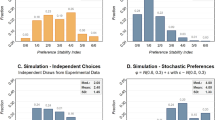Abstract
This paper reports on the responses of 646 individuals to environmental risk information involving different forms of risk ambiguity. Recipients of more than one set of risk information do not simply average the risk levels provided. Rather, a variety of aspects of the nature of the risks that are communicated influence their probabilistic beliefs. Individuals' perceptions of the risk levels to which they are exposed are likely to be greater: (i) for more ambiguous risks, (ii) for risks for which the unfavorable risk evidence is presented last even when there is no temporal order, (iii) for risks for which the most unfavorable risk studies have been performed most recently, and (iv) for risks where there is asymmetry in the risk ambiguity that imposes substantial potential downside risks. Although these effects are modest for the median individual, the potential for extreme responses that reflect only the most adverse or the most favorable piece of information provided is quite prevalent. These findings are of interest more generally in that they indicate how individuals form their risk perceptions in the presence of risk ambiguity.
Similar content being viewed by others
References
Curley, Shawn P., and Yates, J. Frank,: 1985, ‘The Center and Range of the Probability Interval as Factors Affecting Ambiguity Preferences’,Organizational Behavior and Human Decision Process,36, 273–287.
Einhorn, Hillel J., and Hogarth, Robin M.: 1985, ‘Ambiguity and Uncertainty in Probabilistic Inference’,Journal of Business 92 (4), 433–461.
Ellsberg, Daniel: 1961, ‘Risk, Ambiguity, and the Savage Axioms’,Quarterly Journal of Economics,75, 643–669.
Hogarth, Robin M., and Kunreuther, Howard: 1989, ‘Risk, Ambiguity, and Insurance’,Journal of Risk and Uncertainty,2, 5–35.
Kahn, Barbara E., and Sarin, Rakesh K.: 1988, ‘Modeling Ambiguity in Decisions Under Uncertainty’,Journal of Consumer Research,15, 265–272.
Kunreuther, Howard, and Hogarth, Robin M.: 1990, ‘How Does Ambiguity Affect Insurance Decisions?’, Working Paper, Wharton School of Business, University of Pennsylvania.
Magat, Wesley A., Viscusi, W. Kip, Huber, Joel and Payne, John: 1990, ‘Ambiguity and Health Risks’, Working Paper, Duke University.
National Research Council: 1989,Improving Risk Communication, Washington, D.C.: National Academy Press.
Viscusi, W. Kip: 1989: ‘Prospective Reference Theory’,Journal of Risk and Uncertainty,2 (4), 235–264.
Viscusi, W. Kip, and Magat, Wesley A.: 1987,Learning About Risk: Consumer and Worker Responses to Hazard Information, Cambridge: Harvard University Press.
Viscusi, W. Kip, Magat, Wesley A., and Huber, Joel: 1990, ‘Pricing Environmental Health Risks: Survey Assessments of Risk-Risk and Risk-Dollar Trade-Offs for Chronic Bronchitis’, Working Paper, Duke University (1990), forthcoming inJournal of Environmental Economics and Management.
Viscusi, W. Kip, and O'Connor, Charles: 1984, ‘Adaptive Responses to Chemical Labeling: Are Workers Bayesian Decision Makers?’,American Economic Review,74, 942–956.
Author information
Authors and Affiliations
Additional information
The authors would like to thank the U.S. Environmental Protection Agency for support of this work under Cooperative Agreements Number CR-815445-01-2 and Number CR-814388-02-1. Dr. Alan Carlin and Dr. Ann Fisher provided valuable guidance in the design of the project, and Dr. Doyle Graham and Dr. Douglas Anthony offered generous assistance in communicating the medical consequences of nerve disease to subjects. Jon LaScala assisted superbly in the administration and analysis of the survey, and Patricia Born provided additional computer programming assistance.
Rights and permissions
About this article
Cite this article
Viscusi, W.K., Magat, W.A. & Huber, J. Communication of ambiguous risk information. Theor Decis 31, 159–173 (1991). https://doi.org/10.1007/BF00132991
Issue Date:
DOI: https://doi.org/10.1007/BF00132991




